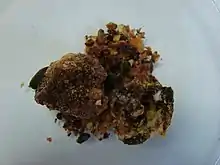Opopanax (perfumery)
Opopanax is the commercial name of bisabol or bissabol, the fragrant gum resin of Commiphora guidottii. It has been a major export article from Somalia since ancient times, and is called hebbakhade, habaghadi or habak hadi in Somali. It is an important ingredient in perfumery and therefore known as scented myrrh, perfumed myrrh or perfumed bdellium.[1]

Etymology
"Opopanax" originally refers to the gum resin from plants of the genus Opoponax which is used in herbal medicine rather than perfumery. In the early 20th century, the name "opopanax" was misapplied to bisabol in perfumery. Nowadays the true opopanax is seldom used and the commercial opopanax is almost exclusively bisabol. To distinguish bisabol from the true opoponax, it is often alternatively spelled opoponax, and sometimes referred to as the opopanax of perfumery or perfumery's opopanax.[1]
Botanical origin
The true botanical origin of perfumery's opopanax is a tree native to Somalia and Ethiopia, Commiphora guidottii.[1]
It has been mistakenly believed that the opopanax of perfumery comes from another Commiphora species, C. kataf (syn. C. holtziana, C. erythraea), known as hagar in Somali, while the true bisabol tree C. guidottii is called hadi in Somali. The confusion between hadi and hagar is attributable to historical misidentification.[1] The gum resin of hagar is sometimes sold under the name of opoponax due to the confusion, though its scent is distinctly different from the authentic opopanax of perfumery. The hagar gum resin has a subtle myrrh-like scent, whereas the opopanax of perfumery is strongly aromatic with a suspicion of turpentine.[2]
The opopanax of perfumery is not so bitter as the true myrrh (bitter myrrh, hirabol) and has a slightly aromatic taste, while the hagar gum resin is only slightly bitter with a suspicion of toffee.[2] Probably because of their less bitter taste, they are both sold as sweet myrrh.
Uses
A resinoid is prepared from the gum resin by solvent extraction. Steam distillation of the resin gives the essential oil, which has a warm, sweet, balsamic odor. Opopanax oil and resinoid are used in perfumes with oriental characteristics. An IFRA recommendation exists.[3]
See also
- L'Opoponax, a 1964 novel by Monique Wittig
- Opopanax (genus)
- Myrrh
- Bdellium
References
- Thulin, Mats; Claeson, Per (1991). "The Botanical Origin of Scented Myrrh (Bissabol or Habak Hadi)". Economic Botany. 45 (4): 487–494. doi:10.1007/BF02930711. ISSN 0013-0001. JSTOR 4255391.
- Drake-Brockman, Ralph E. (1912). "Products of Commercial Value". British Somaliland. London: Hurst & Blackett, Ltd. pp. 239–270.
- Karl-Georg Fahlbusch; et al. (2007), "Flavors and Fragrances", Ullmann's Encyclopedia of Industrial Chemistry (7th ed.), Wiley, pp. 107–108